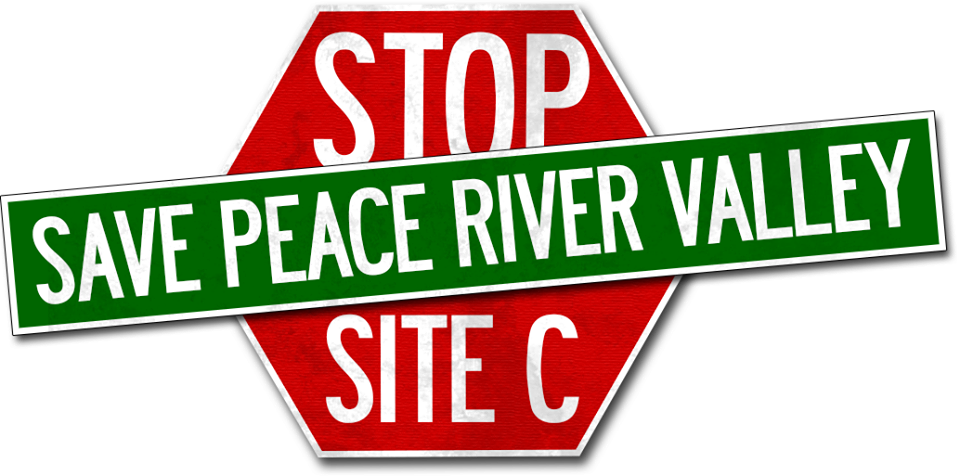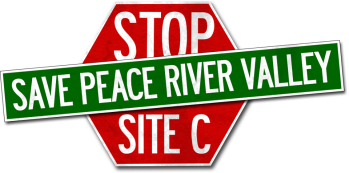Join the discussion to explore the social and legal ramifications of Site C July 5 at Douglas College Aboriginal Gathering Centre.
The social cost of moving forward with Site C, the third major dam on the Peace River in northeastern BC, goes far beyond the obvious cost overruns and rearguard economics. The tension cracks in the river bank where BC Hydro and the BC Government plan to blast aren’t the only cracks that pose a danger. The project will shatter the entire ecosystem of the Peace River Valley.
We’re All Treaty Peoplewill welcome special guest Chief Bob Chamberlin of the Union of B Indian Chiefs and eature Dr. Gordon Christie, Inupiat/Inuvialuit ancestry, UBC specialist in Aboriginal law (bio attached) and Julian Napoleon Dane-zaa and Cree (bio attached) from the Saulteau First Nations, dedicated to raising awareness around Indigenous issues of land, water, food and community. Other guests will include Adrienne Peacock, a Douglas College Professor emeritus who was a member of the BC Utilities Commission when it rejected Site C in the early 80’s and Reverend Emily Smith the Parish Priest at St. Barnabas Anglican Church in New Westminster.
On the value of land to culture and survival, Mr. Napoleon does not mince his words, “In its destruction of invaluable farmland, waterways, and ecologically rich and abundant biocultural heritage areas, the Site C dam endangers all of our long-term resilience, sovereignty, and food security.”
Dr. Christie will bring clarity to the evening by presenting Treaty 8, its legal ramifications and who is responsible for its adherence. The West Moberly and Prophet River cases as well as the Blueberry River case will be explained in accessible language. But he will also discuss how every British Columbian has a responsibility to ensure that Treaty 8 is respected. Dr. Christie emphasizes that, “Canadians are treaty partners within the treaty 8 regime, and so should be concerned that promises made in the treaty—on their behalf—are being upheld.”
Each guest will be asked to answer the following questions:
- Why should the Site C Dam be halted?
- What can we do to stop it.
The evening is a fundraiserand pay-what-you canwith food, videos and a chance to meet people working on-the-ground to stop Site C. All proceeds of the evening will go to three court cases: West Moberly and Prophet River Bands injunction request, the Blueberry River Bands Treaty 8 case and the Peace Valley Landowners Association whose members are the farmers and ranchers whose farms fall within the 140,000 square kilometers of land targeted for flooding for the Site C Dam. That territory is equal to the land between Maple Ridge and Hope. Just think about it.
The event is sponsored by Aboriginal Services, Douglas College and Fight C.
– 30-
30-
Information: Mae Burrows 604-526-1956 (h) 604) 916-9026 (c)


 Like many others who live in the Lower Mainland of British Columbia I’ve never been to the Peace River Valley. I knew nothing of the people who have lived in the area for hundreds if not thousands of years. People in my own family went to work on the first damming of the Peace River known as the W.A.C. Bennett Dam after the B.C. Premier who promoted the dam. No consideration was given to the people whose lands were flooded to create the first dam. Not until 50 years later when in 2017 BC Hydro apologized for the pain and harm brought about by the dam’s construction. But that did not stop BC Hydro or the newly minted coalition government from proceeding with a new dam, the Site C despite strong arguments that it will destroy farm more than it will create well being.
Like many others who live in the Lower Mainland of British Columbia I’ve never been to the Peace River Valley. I knew nothing of the people who have lived in the area for hundreds if not thousands of years. People in my own family went to work on the first damming of the Peace River known as the W.A.C. Bennett Dam after the B.C. Premier who promoted the dam. No consideration was given to the people whose lands were flooded to create the first dam. Not until 50 years later when in 2017 BC Hydro apologized for the pain and harm brought about by the dam’s construction. But that did not stop BC Hydro or the newly minted coalition government from proceeding with a new dam, the Site C despite strong arguments that it will destroy farm more than it will create well being.




